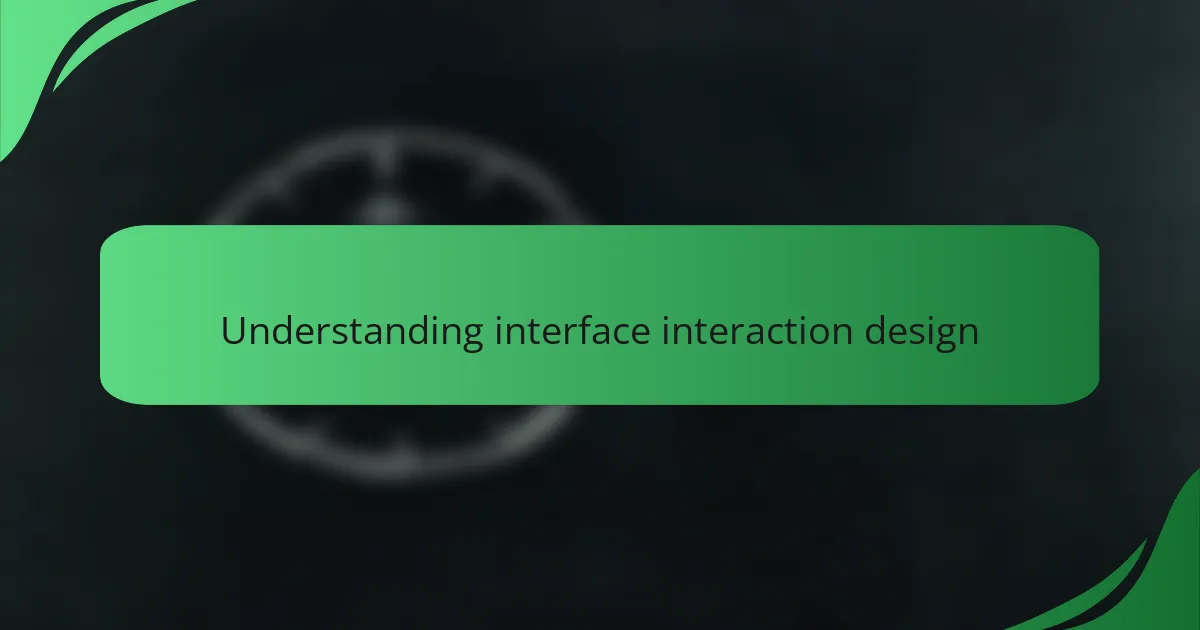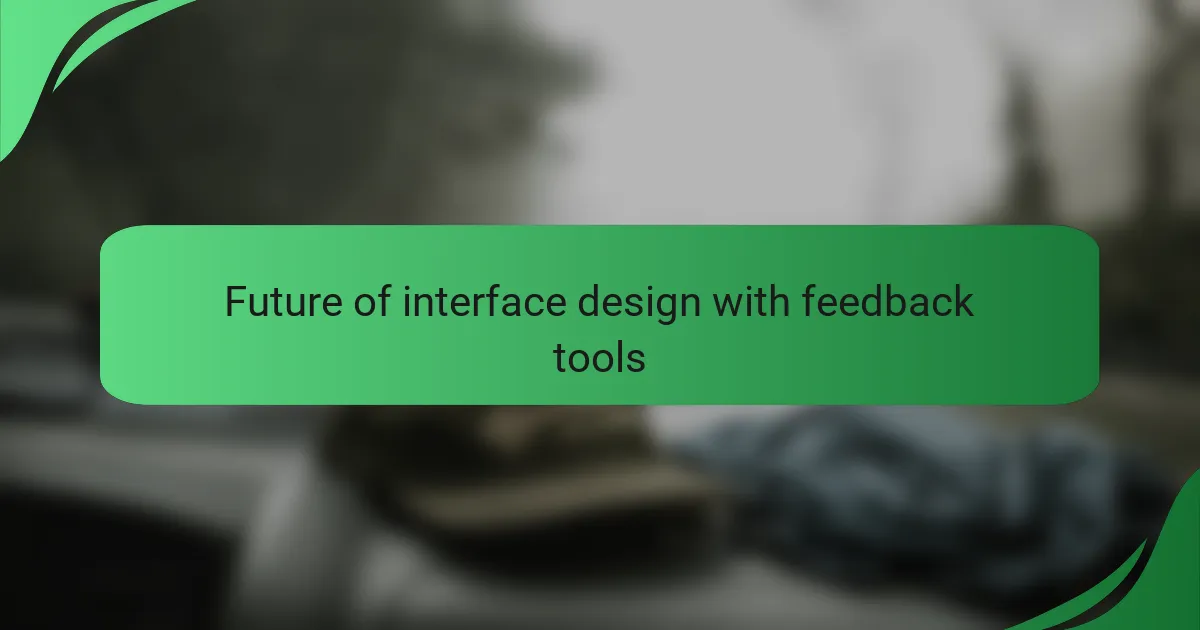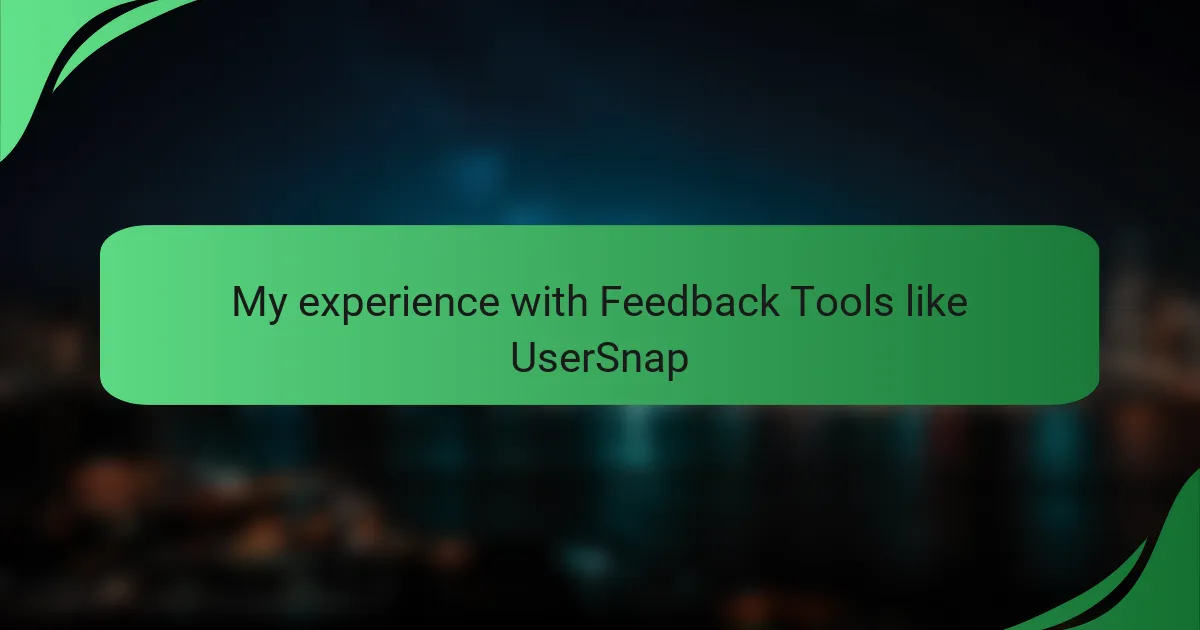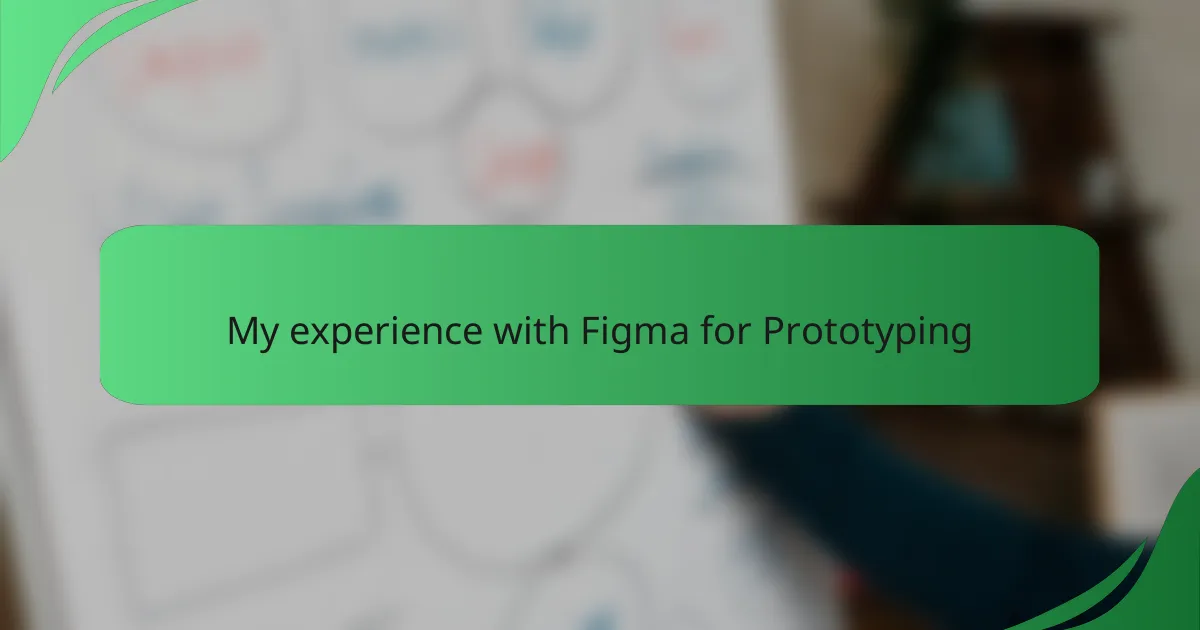Key takeaways
- Understanding user interactions through feedback tools like UserSnap enhances design satisfaction and engagement significantly.
- UserSnap allows for real-time feedback and visualization, enabling quick adjustments and greater responsiveness during the design process.
- Gathering structured, customizable feedback fosters a sense of community and improves user loyalty to products.
- Integrating user feedback into the design process creates a more user-centric approach, facilitating iterative improvements and innovation.

Understanding interface interaction design
Understanding interface interaction design is essential for creating user-friendly products. In my experience, effective design goes beyond aesthetics; it’s about how users interact with technology. I’ve often found that a well-thought-out interface can significantly enhance user satisfaction and engagement.
As I navigated various feedback tools like UserSnap, I realized that understanding user interactions is crucial for refining design. The insights gained from these tools directly inform design decisions, allowing for iterative improvements that resonate with users. This process has taught me that every piece of feedback is an opportunity for growth and learning.
Comparing different feedback tools can also provide clarity on what works best for your specific needs. Here’s a quick table illustrating some key differences:
| Feature | UserSnap | Alternative Tool |
|---|---|---|
| Ease of Use | High | Moderate |
| Integration Options | Many | Few |
| User Feedback Analysis | Real-time | Delayed |

Importance of feedback tools
Feedback tools play a crucial role in interface interaction design by providing valuable insights directly from users. I remember when I first used UserSnap; the immediacy of receiving feedback allowed my team to make real-time adjustments, enhancing user experience greatly. It’s fascinating how a simple comment can lead to significant design improvements, making users feel heard and valued.
The emotional impact of utilizing feedback tools cannot be overstated. When users see their input being acted upon, it fosters a sense of community and loyalty to the product. For instance, I once implemented suggestions from our users that transformed a clunky interface into a smooth, intuitive experience, leading to positive responses and increased user satisfaction.
| Feedback Tool | Key Features |
|---|---|
| UserSnap | Visual feedback, user insights, screenshots |
| Others | Surveys, analytics, limited customization |

Overview of UserSnap
UserSnap is an intuitive feedback tool that offers a seamless way to capture user interactions. I remember my first encounter with it, and I appreciated how easy it was to gather visual feedback directly from users. It felt empowering to transform vague comments into actionable insights, all thanks to the straightforward interface.
This tool stands out with its real-time feedback capabilities, allowing teams to address user concerns as they arise. I recall a project where a user reported a frustrating navigation issue; with UserSnap, we quickly understood the exact problem and made corrections almost immediately. It made me realize how responsive design could elevate user satisfaction by making them feel like active contributors.
Another aspect of UserSnap that I value is its range of integration options. I’ve found that connecting it with other tools in our workflow improved our efficiency remarkably. Why settle for delayed feedback when you can have immediate insights? This kind of agility in today’s fast-paced environment is something I deeply appreciate in a feedback tool.

Personal experience using UserSnap
When I first started using UserSnap, I was genuinely impressed by how intuitive it felt. The ability to capture feedback directly on the website I was testing was a game changer for me. I remember an instance when a client was struggling with a particular feature, and with UserSnap, they could pinpoint exactly what wasn’t working for them. This clarity made it much easier for us to address their concerns.
What struck me most about UserSnap was its seamless integration into my workflow. I can easily gather feedback without interrupting the user’s experience. Here’s a quick rundown of what I found beneficial:
- Visual Feedback: Users could annotate screenshots directly, which provided clear context.
- Customizable Feedback Forms: I appreciated the flexibility in designing questions tailored to my project’s needs.
- Real-Time Notifications: Whenever a piece of feedback came in, I received immediate alerts, allowing for quick responses.
- User-Friendly Dashboard: The dashboard was simple to navigate, making it easy to track and categorize issues.
Overall, my experience with UserSnap has been enriching, enhancing how I approach user feedback and making my design iterations so much more effective.

Key features of UserSnap
UserSnap boasts several key features that make it a standout tool for gathering user feedback. One of my favorite aspects is the ability to capture visual feedback directly on the interface. This functionality transformed how I approached usability testing; instead of relying solely on user interviews, I could now see exactly where users struggled, which was eye-opening. The visual annotations allowed users to highlight issues in real-time, making the feedback more contextual and relatable.
In addition to visual feedback, UserSnap also supports rich, customizable survey forms. I found this feature particularly helpful for gathering detailed insights into user experiences. By tailoring questions to specific tasks or processes, I could drill down into what users truly thought about various aspects of the interface. This tailored approach not only increases the quality of feedback but also helps build a more engaged user community.
Key Features of UserSnap:
– Visual Feedback: Capture screenshots and annotate directly on the interface for clear, contextual insights.
– Custom Surveys: Design personalized surveys to gather specific feedback tailored to user tasks.
– Integrations: Seamlessly connect with tools like Trello and Slack for efficient workflow management.
– Real-time Notifications: Get instant alerts when users submit feedback, allowing for quicker response and iteration.
– User Profiles: Maintain detailed profiles of user feedback trends over time.

Lessons learned from feedback tools
When I first started using feedback tools like UserSnap, I quickly discovered how essential direct user input is for refining designs. I remember receiving a string of comments that pinpointed confusion over a button’s placement; it made me realize that what seems intuitive to me might not feel the same for users. This moment taught me to step back and view my work from the user’s perspective, leading to much clearer interactions in my designs.
Throughout my journey with feedback tools, I have learned several valuable lessons:
- User feedback is crucial for identifying pain points that I might overlook.
- Encouraging a culture of open feedback can lead to unexpected insights.
- Iterative adjustments based on feedback help create a more user-centric design.
- Not all feedback will resonate with the entire audience, so prioritize based on common themes.
- Every piece of feedback, even negative ones, is an opportunity for growth and improvement.

Future of interface design with feedback tools
Engaging with feedback tools like UserSnap shapes the future of interface design in profound ways. In my own experience, the insights gathered from users lead to swift and meaningful changes that enhance overall usability. I’ve often pondered how many more design missteps I might have made without the clarity these tools provide.
The evolution of interface design is increasingly intertwined with user feedback. I remember a project where criticism about a dropdown menu led to a complete redesign that not only improved the functionality but also made the interface visually appealing. It’s fascinating how just a single user’s perspective can spark a chain reaction of innovation and improvement.
As we think about the future, I’m convinced that integrating feedback tools will be essential. They’ll help create an environment where user voices are not just heard but actively shape the design process. Wouldn’t it be incredible if every design decision was rooted in genuine user experiences? That’s the kind of future I’m excited to be part of.




